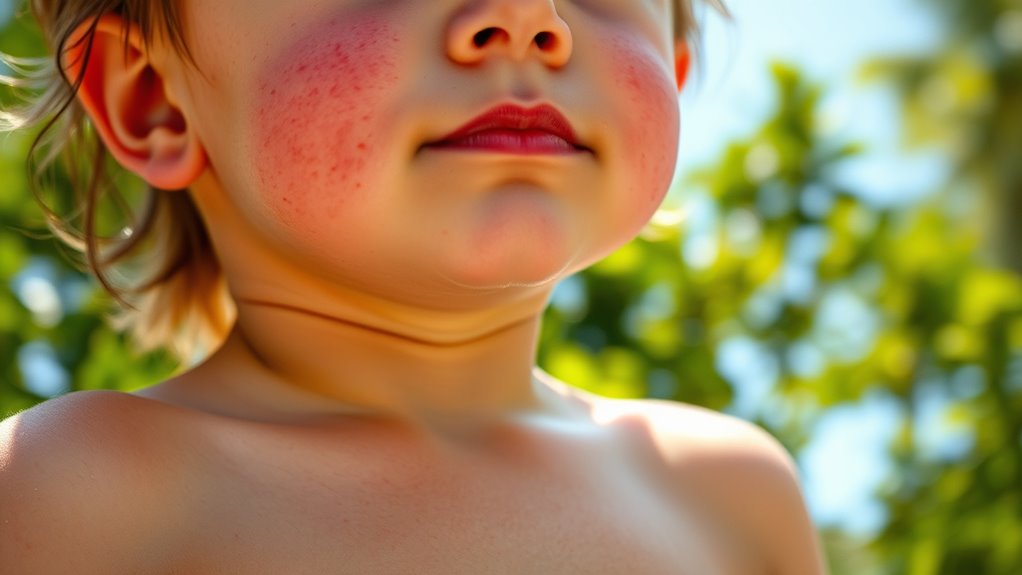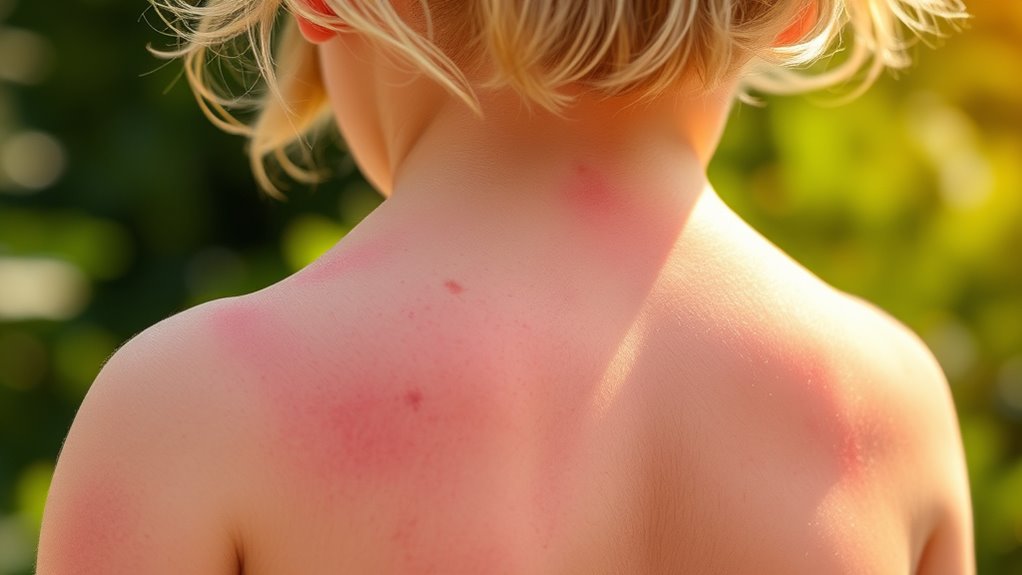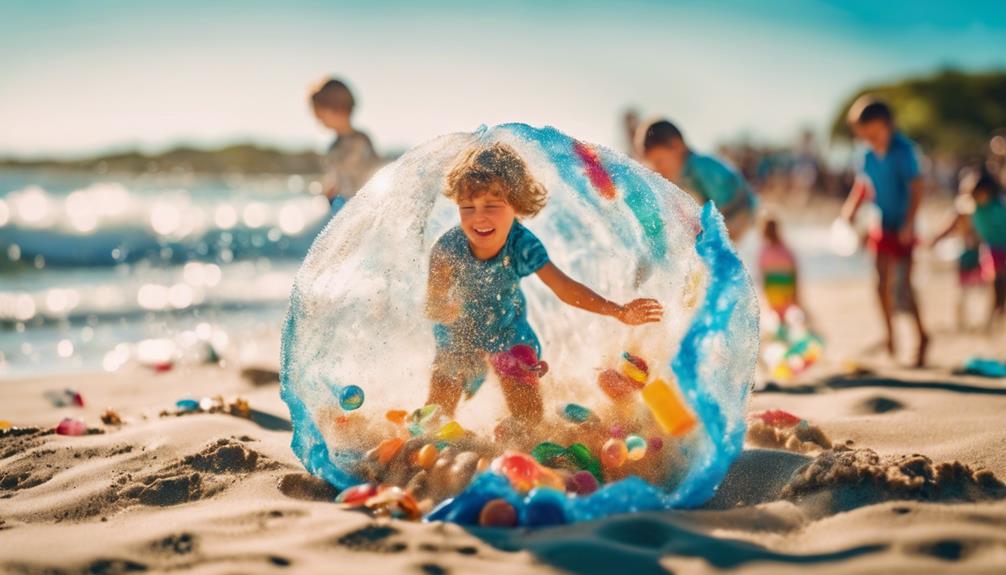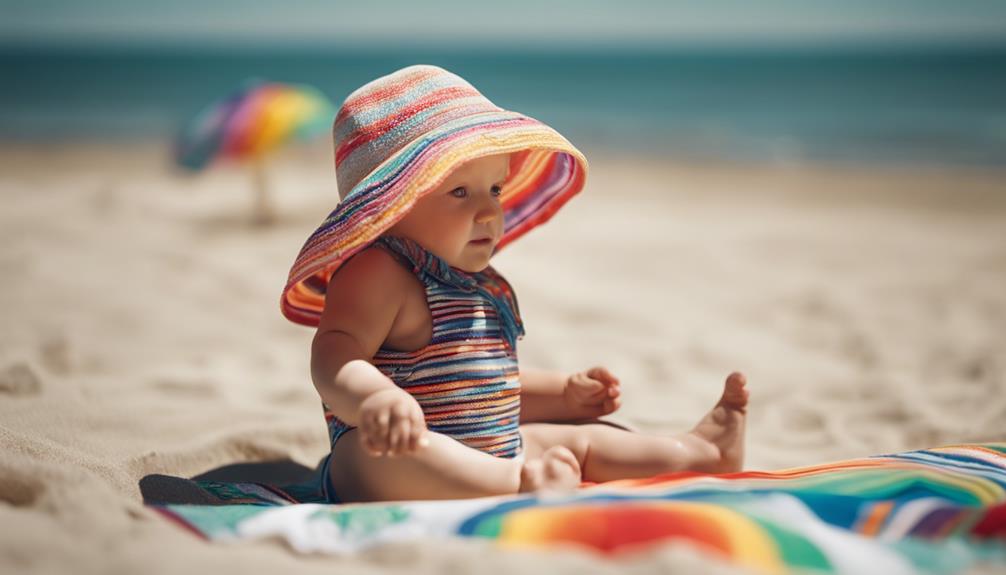Protecting your child from sunburns now can substantially decrease their risk of skin damage and skin cancer later in life. Use broad-spectrum sunscreen with at least SPF 30, reapply regularly, and dress your child in protective clothing and hats. Seek shade during peak hours and teach sun safety habits early. Taking these simple steps can make a big difference in their long-term health. Keep going to discover even more effective ways to protect your child’s skin.
Key Takeaways
- Childhood sunburns increase the risk of developing skin cancer later in life.
- Consistent use of broad-spectrum SPF 30+ sunscreen reduces UV damage in children.
- Protective clothing, hats, and seeking shade help prevent sunburn and long-term skin harm.
- Educating children early about sun safety promotes lifelong protective habits.
- Prompt treatment of sunburns minimizes skin damage and supports skin healing.

Childhood sunburns are a common concern for many parents, especially during warm, sunny days when kids love to play outside. While it’s natural to want your children to enjoy the outdoors, it’s vital to prioritize their skin’s health by implementing effective sun protection strategies. You can start by ensuring they wear broad-spectrum sunscreen with at least SPF 30, applying it generously 15 minutes before heading outdoors. Don’t forget to reapply every two hours, or more often if your child is swimming or sweating. Dressing your kids in lightweight, long-sleeved shirts, wide-brimmed hats, and sunglasses can provide extra layers of defense against harmful UV rays. Seeking shade during the peak sunlight hours—typically between 10 a.m. and 4 p.m.—can considerably reduce their exposure. Educate your children about the importance of sun safety, encouraging them to take breaks in shaded areas and to understand why protecting their skin now helps prevent long-term damage. Proper sun protection can also be enhanced by understanding how raw food diets promote overall health, including skin health, through natural nutrition sources.
When a sunburn does occur, it’s essential to follow sunburn healing tips to soothe your child’s skin and promote recovery. First, run cool (not cold) water over the affected areas or apply a cool, damp cloth to reduce heat and discomfort. Avoid using harsh soaps or fragrances that can irritate sensitive skin further. Applying aloe vera gel or over-the-counter hydrocortisone cream can help calm inflammation and alleviate pain, but always check with your pediatrician before using medicated creams. Keep your child well-hydrated, as sunburns can dehydrate the skin and body, so encourage plenty of fluids. Dress them in loose, soft clothing to prevent further irritation and encourage them to rest as their skin heals. If blisters develop or if your child shows signs of severe pain, fever, chills, or nausea, seek medical attention promptly. The key is to stay vigilant and proactive—early care can make a vital difference in recovery and reduce the risk of complications.
Frequently Asked Questions
Can Sunburns in Childhood Cause Skin Cancer Later in Life?
Yes, sunburns in childhood can increase your risk of skin cancer later in life. When you get sunburned, it damages your skin’s DNA, and genetic factors can influence how your body repairs that damage. A weakened immune response also makes it harder for your body to fight off abnormal cells. Protecting your skin early on helps reduce these risks, so always wear sunscreen and avoid peak sun hours.
Are Certain Skin Types More Vulnerable to Childhood Sunburns?
Yes, certain skin types are more vulnerable to childhood sunburns. If you have fair skin, light eyes, or a history of skin cancer in your family, your skin type vulnerability increases. Your genetic predisposition plays a role in how easily you burn and your overall risk. To protect your child, encourage sun safety habits early, like wearing protective clothing and applying broad-spectrum sunscreen regularly.
How Does Indoor Sun Exposure Affect Childhood Skin Health?
Indoor UV exposure might seem harmless, but it still impacts your child’s skin health. While it helps with Vitamin D synthesis, too much can cause skin damage over time. You might think staying indoors keeps kids safe, but windows don’t block UV rays entirely. Encourage safe outdoor play and protective clothing to balance Vitamin D benefits with skin protection, reducing long-term risks of sun damage and skin issues later in life.
What Are the Long-Term Cosmetic Effects of Childhood Sunburns?
You may notice long-term cosmetic effects from childhood sunburns like skin discoloration and premature aging. Sun damage early in life can cause dark spots, uneven skin tone, and wrinkles over time. Protecting your child’s skin now helps prevent these issues later. By avoiding excessive sun exposure and using proper sun protection, you reduce the risk of lasting cosmetic effects, keeping skin healthier and more youthful in the future.
Can Sunscreen Ingredients Cause Allergic Reactions in Children?
Yes, sunscreen ingredients can cause allergic reactions in children. Some ingredients, like oxybenzone, avobenzone, or fragrance components, may trigger sensitivities or skin irritation. To minimize risks, choose mineral-based sunscreens with zinc oxide or titanium dioxide, which are less likely to cause allergies. Always perform a patch test before full application, and consult your child’s pediatrician if you notice any allergic reactions or irritation.
Conclusion
Protecting your little one from sunburn now is like guiding a delicate flower through gentle rain—you nurture their future glow and keep their vibrant spirit alive. By taking simple steps to shield their skin, you’re helping them avoid the quiet storms that can linger long after the sun sets. Remember, a little care today plants the seeds for a brighter, healthier tomorrow. Cherish those sunny moments, knowing you’re giving them the gift of lasting warmth and well-being.









